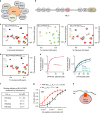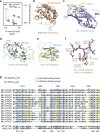Selective binding of the PHD6 finger of MLL4 to histone H4K16ac links MLL4 and MOF
- PMID: 31127101
- PMCID: PMC6534582
- DOI: 10.1038/s41467-019-10324-8
Selective binding of the PHD6 finger of MLL4 to histone H4K16ac links MLL4 and MOF
Abstract
Histone methyltransferase MLL4 is centrally involved in transcriptional regulation and is often mutated in human diseases, including cancer and developmental disorders. MLL4 contains a catalytic SET domain that mono-methylates histone H3K4 and seven PHD fingers of unclear function. Here, we identify the PHD6 finger of MLL4 (MLL4-PHD6) as a selective reader of the epigenetic modification H4K16ac. The solution NMR structure of MLL4-PHD6 in complex with a H4K16ac peptide along with binding and mutational analyses reveal unique mechanistic features underlying recognition of H4K16ac. Genomic studies show that one third of MLL4 chromatin binding sites overlap with H4K16ac-enriched regions in vivo and that MLL4 occupancy in a set of genomic targets depends on the acetyltransferase activity of MOF, a H4K16ac-specific acetyltransferase. The recognition of H4K16ac is conserved in the PHD7 finger of paralogous MLL3. Together, our findings reveal a previously uncharacterized acetyllysine reader and suggest that selective targeting of H4K16ac by MLL4 provides a direct functional link between MLL4, MOF and H4K16 acetylation.
Conflict of interest statement
The authors declare no competing interests.
Figures







Similar articles
-
Histone H4K16ac Binding Function of the Triple PHD Finger Cassette of MLL4.J Mol Biol. 2024 Apr 1;436(7):168212. doi: 10.1016/j.jmb.2023.168212. Epub 2023 Jul 20. J Mol Biol. 2024. PMID: 37481158 Free PMC article.
-
Cross-talk between the H3K36me3 and H4K16ac histone epigenetic marks in DNA double-strand break repair.J Biol Chem. 2017 Jul 14;292(28):11951-11959. doi: 10.1074/jbc.M117.788224. Epub 2017 May 25. J Biol Chem. 2017. PMID: 28546430 Free PMC article.
-
ASXLs binding to the PHD2/3 fingers of MLL4 provides a mechanism for the recruitment of BAP1 to active enhancers.Nat Commun. 2024 Jun 7;15(1):4883. doi: 10.1038/s41467-024-49391-x. Nat Commun. 2024. PMID: 38849395 Free PMC article.
-
The MLL3/4 H3K4 methyltransferase complex in establishing an active enhancer landscape.Biochem Soc Trans. 2021 Jun 30;49(3):1041-1054. doi: 10.1042/BST20191164. Biochem Soc Trans. 2021. PMID: 34156443 Free PMC article. Review.
-
The Functional Analysis of Histone Acetyltransferase MOF in Tumorigenesis.Int J Mol Sci. 2016 Jan 14;17(1):99. doi: 10.3390/ijms17010099. Int J Mol Sci. 2016. PMID: 26784169 Free PMC article. Review.
Cited by
-
It's all in the combination: decoding the epigenome for cancer research and diagnostics.Curr Opin Genet Dev. 2022 Apr;73:101899. doi: 10.1016/j.gde.2022.101899. Epub 2022 Jan 25. Curr Opin Genet Dev. 2022. PMID: 35091256 Free PMC article. Review.
-
Characterization of the plant homeodomain (PHD) reader family for their histone tail interactions.Epigenetics Chromatin. 2020 Jan 24;13(1):3. doi: 10.1186/s13072-020-0328-z. Epigenetics Chromatin. 2020. PMID: 31980037 Free PMC article.
-
Insights on the regulation of the MLL/SET1 family histone methyltransferases.Biochim Biophys Acta Gene Regul Mech. 2020 Jul;1863(7):194561. doi: 10.1016/j.bbagrm.2020.194561. Epub 2020 Apr 15. Biochim Biophys Acta Gene Regul Mech. 2020. PMID: 32304759 Free PMC article. Review.
-
Interpreting Combinatorial Epigenetic Modifications for Biological Meaning.J Mol Biol. 2024 Apr 1;436(7):168501. doi: 10.1016/j.jmb.2024.168501. Epub 2024 Feb 22. J Mol Biol. 2024. PMID: 38401624 Free PMC article. No abstract available.
-
MLL4 binds TET3.Structure. 2024 Jun 6;32(6):706-714.e3. doi: 10.1016/j.str.2024.03.005. Epub 2024 Apr 4. Structure. 2024. PMID: 38579707 Free PMC article.
References
Publication types
MeSH terms
Substances
Grants and funding
- DK071900/U.S. Department of Health & Human Services | NIH | National Institute of Diabetes and Digestive and Kidney Diseases (National Institute of Diabetes & Digestive & Kidney Diseases)/International
- R01 GM125195/GM/NIGMS NIH HHS/United States
- CA129325/U.S. Department of Health & Human Services | NIH | National Cancer Institute (NCI)/International
- R01 GM100907/GM/NIGMS NIH HHS/United States
- GM126900/U.S. Department of Health & Human Services | NIH | National Institute of General Medical Sciences (NIGMS)/International
- P30 CA016086/CA/NCI NIH HHS/United States
- GM106416/U.S. Department of Health & Human Services | NIH | National Institute of General Medical Sciences (NIGMS)/International
- R01 DK071900/DK/NIDDK NIH HHS/United States
- R01 GM106416/GM/NIGMS NIH HHS/United States
- R01 CA129325/CA/NCI NIH HHS/United States
- GM124736/U.S. Department of Health & Human Services | NIH | National Institute of General Medical Sciences (NIGMS)/International
- R35 GM126900/GM/NIGMS NIH HHS/United States
- GM100907/U.S. Department of Health & Human Services | NIH | National Institute of General Medical Sciences (NIGMS)/International
- GM125195/U.S. Department of Health & Human Services | NIH | National Institute of General Medical Sciences (NIGMS)/International
- R01 CA204020/CA/NCI NIH HHS/United States
- R35 GM124736/GM/NIGMS NIH HHS/United States
LinkOut - more resources
Full Text Sources
Molecular Biology Databases
Miscellaneous

